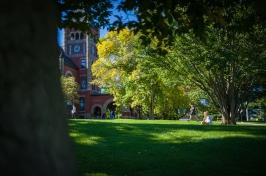Color, Color Everywhere - Mother Nature Shares a Mosaic of Bright Colors This Fall

Leaves of a red oak captured around the time show how different layers of the tree canopy can develop at different times, with the outer layer usually changing first. (Photo credit: UNH Extension)
DURHAM, N.H. — Cool, crisp weather can trigger the urge to get out and go leaf peeping and this year could be a particularly good year to hit the road and admire New England’s spectacular foliage season. According to Steve Roberge, Extension forestry specialist and professor of natural resources at the University of New Hampshire, we should expect to see Mother Nature put on a brightly colored show this fall.
“I am of the thought that fall foliage in New England is phenomenal every year because it is different year to year and always something impressive to see,” said Roberge. “But yes, the conditions this year are especially favorable for a bright spectrum of colors in New Hampshire and across New England.”
According to Roberge, in general, good foliage occurs when there is sufficient rainfall during the growing season and plenty of warm, sunny days and clear, cool nights in the late summer and early autumn. Even though there were some unusually hot and humid conditions in New England this year, there was not any significant drought or widespread pest or insect outbreak so the leaves remained fairly healthy.
“Brighter leaf colors in any particular year are absolutely driven by the weather - rainfall and sunshine tend to be the biggest factors determining the deep hues of fall foliage,” said Roberge. “But even in a bad weather year you will still see color because it is already in the leaves, it is just hidden, and their reveal is controlled by the length of the days and nights as we head into fall.”
Roberge explains that as the days get shorter and the nights get longer and colder, it causes the production of chlorophyll – the green color in leaves - to slow down. When that happens, it unmasks pigments hidden in the leaf, known as carotenoids and anthocyanin, and reveals the colors seen in the fall - the yellow, brown and russet, or the red and orange, respectively.
Each tree species starts to shut down production at its own pace with red maples in low lying areas and swamps showing off their colors first, often in mid-August. Other species like oak, ash, birch and other maples, need the long cool nights to show off their yellows, oranges and purples.
“There are so many factors at play that I tell people not to worry about trying to pick ‘the’ perfect day, enjoy the entire season,” said Roberge. “We’re lucky in New Hampshire to have such a diversity of tree types and landscapes from tall mountains to the seacoast that give us close to two months of color. So, get out into nature - drive up north, go for a hike, walk around your town, or simply look out the window, pick a tree and watch it change every day as it lights up with color.”
PHOTOS TO DOWNLOAD
Caption: Red maples in low lying areas tend to show off their colors first when the pigment called anthocyanin is unmasked revealing a bright color red.
Photo credit: UNH Extension
http://f0s6.a220149.com/unhtoday/sites/default/files/foliage_-_red_oak.jpg
Caption: Leaves of a red oak captured around the time show how different layers of the tree canopy can develop at different times, with the outer layer usually changing first.
Photo credit: UNH Extension
http://f0s6.a220149.com/unhtoday/sites/default/files/foliage_-_red_and_yellow.jpg
Caption: Red maple tree shows off two different colors.
Photo credit: UNH Extension
About UNH
The University of New Hampshire inspires innovation and transforms lives in our state, nation and world. More than 16,000 students from 50 states and 87 countries engage with an award-winning faculty in top-ranked programs in business, engineering, law, health and human services, liberal arts and the sciences across more than 200 programs of study. A Carnegie Classification R1 institution, UNH partners with NASA, NOAA, NSF, and NIH, and received over $210 million in competitive external funding in FY23 to further explore and define the frontiers of land, sea and space.
Latest News
-
November 22, 2024
-
November 7, 2024
-
October 30, 2024
-
October 10, 2024
-
October 8, 2024



















































